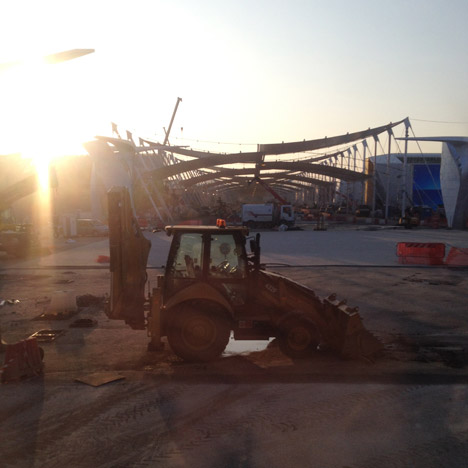Milan Expo 2015: two weeks ahead of opening day, the Milan Expo is still a building site and designers say some pavilions may not be finished in time.
Speaking at the preview of the British pavilion this week, artist Wolfgang Buttress told Dezeen that a number of pavilions "haven't a hope in hell" of completing for the 1 May opening.
The Czech pavilion and the UK pavilion, designed by Buttress with engineer Tristan Simmonds, are among the small number of structures on the site that are ready to receive visitors.
Asked if he thought the rest of the Expo site would be ready on time, Buttress said that some of the pavilions would struggle.
"Some of them might put the cladding on, but I don't know what's going to go on the inside," he told Dezeen. "Some you look at and you think, no, they haven't a hope in hell. But it's a theatre, it is about the surface. I'm sure that come May the first a lot of it will look really impressive."
Earlier in the week Oki Sato, head of Japanese design studio Nendo who is contributing to the Atsushi Kitagawara-designed Japanese pavilion, also said that the Expo looked unlikely to be ready in time.
Speaking to Dezeen at the opening of his retrospective exhibition during Milan design week, Sato said it looked like there was still six months' worth of work to be done on the site.
"It won't open for six months, that is how it seems," he said. "I was saying yesterday 'I'm not sure if it's going to open'."
During Dezeen's visit to the site on the outskirts of the city on Wednesday, concrete was still being poured and cranes were lifting structural elements of pavilions into place.
At the beginning of April, reports in the Italian press suggested that only nine per cent of pavilions had been completed.
Milan news outlet Repubblica reported one technician as saying it would need "a miracle" for the Italian pavilion to be completed on time.
Expo organisers are planning to spend almost €3 million on 11,000 square metres of temporary screens, officially described as "external exhibition elements" in the contract for the work, to hide ongoing construction work when the site opens to the public.
The cost of the project, dubbed "operation camouflage" by the Italian media, is in addition to the €1.3 billion the Italian government has already invested in the Expo.
Expo commissioner Giuseppe Sala – who also became commissioner for the Italian pavilion last year after its former manager was accused of corruption – said that "one or two" of the more than 140 pavilions may not be finished on time, but the site would be "90 per cent ready" for opening day.
A source told Dezeen that Italian journalists have now been banned from the Expo site.
The Milan Expo 2015, which has the theme of Feeding the Planet, Energy for Life, includes purpose-built showcases from around 140 countries and organisations, and occupies a site near Rho Fiera close to the Salone del Mobile exhibition grounds.
Expected to attract more than 20 million visitors, the Expo is due to open to the public on 1 May and will run until 31 October – after which the majority of the pavilions on the site will be demolished.
The British pavilion is one of the only structures designed to be shipped back and rebuilt in its home country after the event.
"The theme of this year's Expo is Feeding the Planet, which is fantastic, it's really laudable," said Buttress. "But how do you square that with building nearly 150 pavilions, all spending 10-20-30 million plus, which is a lot of money. There is an inherent contradiction and irony in that."
Last month architect Jacques Herzog, co-founder of Swiss firm Herzog & de Meuron, launched an attack against the Milan Expo, which he described as a "vanity fair".
Herzog was originally invited by Italian architect Stefano Boeri in 2009 to help masterplan the Expo site, but had walked off the project by 2011 along with American designer William McDonough and British urban designer Ricky Burdett who had also been part of the design team.
Herzog said this was because the organisers were not "powerful or courageous enough" to support their ideas, and had instead reverted to "the same kind of vanity fair that we've seen in the past".
The Milan Expo 2015 organisation did not respond to Dezeen's requests for comment.
Additional reporting is by Dan Howarth.
Photographs of the Milan Expo site, taken during a visit on 15 May, are by Dezeen.

